Wednesday, August 30, 2006
Strategy: Futile
We have a dog.
Her name is Wan Wan.
I can't say that she is a dumb dog.
She is toilet-trained but she pees on everywhere except her designated toilet space.
This drives my mother crazy.
So she has came up with a strategy to not clean up the mess.
And hopefully this will annoy my sister enough to send the dog away.
What she cannot understand is that this will never happen.
So her strategy only annoys my sister.
My sister is also trying to improve the situation.
She talks to the dog everyday.
"Wan Wan. You must be a good girl. Must go onto the newspaper to urine."
If only pigs can fly.
None of the women are thinking properly.
The solution is simply to train and beat the dog whenever neccessary.
But one is torturing her daughter.
And the other is plain crazy.
Lesson One: Animal or not. A Dog (or a bitch) will be Dog. They only cause you trouble.
(To my female counterparts, some are just not worth keeping.)
I tried to keep my mouth shut.
But knowing me, it didn't last long.
Still, one is torturing her daughter.
And the other still believes that the dog will one day be moved to not dirty the house.
Lesson Two: As long as you in the minority, it doesn't matter if you make sense or not.
Unfair as it sounds, sometimes, you only need the louder voice to win.
So I thought what is wrong with the situation.
You have two persons who keeps harping on about the dog.
But everyday you see them prattling on as they are cleaning up the dog's wastes.
Dog ONE! Human ZERO!!
Lesson Three: Homo Sapiens is all talk but no action species.
Her name is Wan Wan.
I can't say that she is a dumb dog.
She is toilet-trained but she pees on everywhere except her designated toilet space.
This drives my mother crazy.
So she has came up with a strategy to not clean up the mess.
And hopefully this will annoy my sister enough to send the dog away.
What she cannot understand is that this will never happen.
So her strategy only annoys my sister.
My sister is also trying to improve the situation.
She talks to the dog everyday.
"Wan Wan. You must be a good girl. Must go onto the newspaper to urine."
If only pigs can fly.
None of the women are thinking properly.
The solution is simply to train and beat the dog whenever neccessary.
But one is torturing her daughter.
And the other is plain crazy.
Lesson One: Animal or not. A Dog (or a bitch) will be Dog. They only cause you trouble.
(To my female counterparts, some are just not worth keeping.)
I tried to keep my mouth shut.
But knowing me, it didn't last long.
Still, one is torturing her daughter.
And the other still believes that the dog will one day be moved to not dirty the house.
Lesson Two: As long as you in the minority, it doesn't matter if you make sense or not.
Unfair as it sounds, sometimes, you only need the louder voice to win.
So I thought what is wrong with the situation.
You have two persons who keeps harping on about the dog.
But everyday you see them prattling on as they are cleaning up the dog's wastes.
Dog ONE! Human ZERO!!
Lesson Three: Homo Sapiens is all talk but no action species.
Labels: Gage'sWritings, Thoughts
Sunday, August 27, 2006
Misunderstanding Waiting to Happen
In japanese, steamboat(Simplified Chinese: 火锅; pinyin: huǒguō), known also as the hot pot, is Nah Beh.
Crab Steamboat is Kan Ni Nah Beh.
These words in dialect are very crude words used to curse.
Like they say, one man's meat is another's poison.
Be careful when you want to eat steamboat next time!
hee.
Crab Steamboat is Kan Ni Nah Beh.
These words in dialect are very crude words used to curse.
Like they say, one man's meat is another's poison.
Be careful when you want to eat steamboat next time!
hee.
Labels: Thoughts
Thursday, August 17, 2006
Friend
A real friend is one who will continue to talk to you over the back fence even though he knows he's missing his favorite television program.
Labels: Quotes
Wednesday, August 16, 2006
la discothèque a besoin de vous
The various architectural styles of the temples and the cravings found on the walls are really very unique. For me, the experience is especially special because there are no such great empires found in Singapore. At the back of my mind, I was trying to calculate how long those people a thousand years ago had taken to crave out each and every figure and pattern. And I think no modern technology will be able to create such fine art ever again.
When I was looking at the beautiful temples in Angkor, a french sentence I read the day before struck me: la discothèque a besoin de vous (translates to: the disco needs you).
Allow me to explain. I have always thought of life as a big dance floor. Hence, the reason why I am using the word 'disco'. But for anyone else, 'disco' can be replaced by whatever is more applicable. It can be 'a marathon' or even 'a box of chocolates'.
Also, in french, 'vous' means 'you' but it can also be used to address a group of people.
Some of us believe that to be admired, we must start from within.
Like many will tell me, "No one will love you, unless you know how to love yourself."
I couldn't agree with this more.
I have seen too many people on a never ending diet; or people chasing after the lastest fashion trends blindly.
What we need to understand is that everything starts from inside - your disco needs you.
But then, I thought of the Angkor Wat, the Pyramids and even Marilyn Monroe.
Would all the icons and idols be icons and idols if there are no one to appreciate them?
I doubt so.
We always talk about cause and effect; and how nobody is a lone island.
Behind every idol, there must be an audience.
Hence, come the appropriateness of the sentence: la discothèque a besoin de vous.
We all need to take care of our own oneself but also need other people.
We are all linked to one another.
My decisions affect you, and your actions impact mine.
No one is forsaken, no one is absolutely safe.
When I was looking at the beautiful temples in Angkor, a french sentence I read the day before struck me: la discothèque a besoin de vous (translates to: the disco needs you).
Allow me to explain. I have always thought of life as a big dance floor. Hence, the reason why I am using the word 'disco'. But for anyone else, 'disco' can be replaced by whatever is more applicable. It can be 'a marathon' or even 'a box of chocolates'.
Also, in french, 'vous' means 'you' but it can also be used to address a group of people.
Some of us believe that to be admired, we must start from within.
Like many will tell me, "No one will love you, unless you know how to love yourself."
I couldn't agree with this more.
I have seen too many people on a never ending diet; or people chasing after the lastest fashion trends blindly.
What we need to understand is that everything starts from inside - your disco needs you.
But then, I thought of the Angkor Wat, the Pyramids and even Marilyn Monroe.
Would all the icons and idols be icons and idols if there are no one to appreciate them?
I doubt so.
We always talk about cause and effect; and how nobody is a lone island.
Behind every idol, there must be an audience.
Hence, come the appropriateness of the sentence: la discothèque a besoin de vous.
We all need to take care of our own oneself but also need other people.
We are all linked to one another.
My decisions affect you, and your actions impact mine.
No one is forsaken, no one is absolutely safe.
Labels: Thoughts
Monday, August 14, 2006
I Can Never Quite Leave You
I want to grow up
I want to see the world
I want to leave this dump
So I am on my way
I want to leave your shadow
You don't know what I want
You don't know what is best for me
So let me be. I need to go
So I grow
I travel far from home to work
So I put myself out of my comfort zone
And I am going to leave you
So I plan
I am going to leave all these behind
So I try new things
And make you worry
But when I turned back to wave goodbye that day
I saw the sadness in your eyes
You didnt know I was looking
But you quickly smiled back when you saw me looking back
Then I had a realisation
I can never quite leave you
Even after making up my mind to leave this dumpster
I can never quite leave you
for mommy
I want to see the world
I want to leave this dump
So I am on my way
I want to leave your shadow
You don't know what I want
You don't know what is best for me
So let me be. I need to go
So I grow
I travel far from home to work
So I put myself out of my comfort zone
And I am going to leave you
So I plan
I am going to leave all these behind
So I try new things
And make you worry
But when I turned back to wave goodbye that day
I saw the sadness in your eyes
You didnt know I was looking
But you quickly smiled back when you saw me looking back
Then I had a realisation
I can never quite leave you
Even after making up my mind to leave this dumpster
I can never quite leave you
Labels: Gage'sWritings, Thoughts
Saturday, August 12, 2006
Bayon
The Bayon was built in the 13th century as the state temple of king Jayavarman VII, and stands at the centre of his capital, Angkor Thom. Its most distinctive feature is the multitude of smiling faces on the towers which rise up to its central peak. It also possesses two sets of bas-reliefs, which depict an unusual combination of mythological, historical and mundane events.
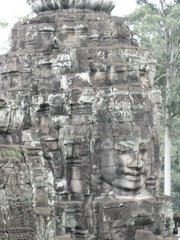
The Bayon was the last state temple to be built at Angkor, and the only one to be built primarily as a Mahayana Buddhist temple (although various local deities were also worshipped there). Under the reign of Jayavarman VIII in the mid-13th century the temple was converted to Hinduism. In later centuries Theravada Buddhism became dominant, before the temple was eventually abandoned to the jungle.

In the first part of the 20th century conservation work was led by the Ecole Française d'Extrême-Orient, which restored the temple using the anastylosis technique. Since 1995 the Japanese Government team for the Safeguarding of Angkor (the JSA) has been the main conservatory body, holding annual symposia.

I was listening to a Singaporean tour group at the corner. There were about 10 aunties and 3 uncles. It was there that I realised that Singaporean English is so distinct. We have some tones and stresses that immediately say 'Singapore'!
Bayon is my favourite temple of all. I always thought that (when I was doing my readups before the trip) it is a scary place because of the 'faces'. But I absolutely love the place. It was also the place that I start to look forward to see more temples. It was there that I realised sitting down and be part of the place is very enjoyable too.

The Bayon was the last state temple to be built at Angkor, and the only one to be built primarily as a Mahayana Buddhist temple (although various local deities were also worshipped there). Under the reign of Jayavarman VIII in the mid-13th century the temple was converted to Hinduism. In later centuries Theravada Buddhism became dominant, before the temple was eventually abandoned to the jungle.

In the first part of the 20th century conservation work was led by the Ecole Française d'Extrême-Orient, which restored the temple using the anastylosis technique. Since 1995 the Japanese Government team for the Safeguarding of Angkor (the JSA) has been the main conservatory body, holding annual symposia.

I was listening to a Singaporean tour group at the corner. There were about 10 aunties and 3 uncles. It was there that I realised that Singaporean English is so distinct. We have some tones and stresses that immediately say 'Singapore'!
Bayon is my favourite temple of all. I always thought that (when I was doing my readups before the trip) it is a scary place because of the 'faces'. But I absolutely love the place. It was also the place that I start to look forward to see more temples. It was there that I realised sitting down and be part of the place is very enjoyable too.
Angkor Wat
Angkor Wat is a temple at Angkor, Cambodia, built for king Suryavarman II in the early 12th century as his state temple and capital city. The largest and best-preserved temple at the site, it is the only one to have remained a significant religious centre—first Hindu, then Buddhist—since its foundation. The temple is the epitome of the high classical style of Khmer architecture. It has become a symbol of Cambodia, appearing on its national flag, and it is the country's prime attraction for visitors. Angkor Wat combines two basic plans of Khmer temple architecture: the temple mountain and the later galleried temples. It is designed to represent Mount Meru, home of the gods in Hindu mythology: within a moat and an outer wall 3.6 km long are three rectangular galleries, each raised above the next. At the centre of the temple stands a quincunx of towers. Unlike most Angkorian temples, Angkor Wat is orientated to the west; scholars are divided as to the significance of this. As well as for the grandeur and harmony of the architecture, the temple is admired for its extensive bas-reliefs and for the numerous devatas adorning its walls.

The initial design and construction of the temple took place in the first half of the 12th century, during the reign of Suryavarman II (ruled 1113–c. 1150). Dedicated to Vishnu, it was built as the king's state temple and capital city. As neither the foundation stela nor any contemporary inscriptions referring to the temple have been found, its original name is unknown. It is located 5.5 km north of the modern town of Siem Reap, and a short distance south and slightly east of the previous capital, which was centred on the Baphuon. Work seems to have come to an end on the king's death, with some of the bas-reliefs unfinished. In 1177 Angkor was sacked by the Chams, the traditional enemies of the Khmer. Thereafter the empire was restored by a new king, Jayavarman VII, who established a new capital and state temple (Angkor Thom and the Bayon respectively) which lie a few kilometres to the north.

In the 14th or 15th century the temple was converted to Theravada Buddhist use, which continues to the present day. Angkor Wat is unusual among the Angkor temples in that although it was somewhat neglected after the 16th century it was never completely abandoned. Its moat also provided some protection from encroachment by the jungle. Around this time the temple was known as Preah Pisnulok, after the posthumous title of Suryavarman. The modern name, in use by the 16th century, means "City Temple": Angkor is a vernacular form of the word nokor which comes from the Sanskrit word nagara (capital), while wat is the Khmer word for temple.
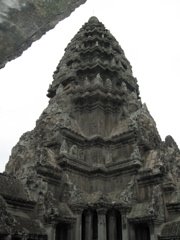
Architecturally, the elements characteristic of the style include: the ogival, redented towers shaped like lotus buds; half-galleries to broaden passageways; axial galleries connecting enclosures; and the cruciform terraces which appear along the main axis of the temple. Most of the visible areas are of sandstone blocks, while laterite was used for the outer wall and for hidden structural parts. Other elements of the design have been destroyed by looting and the passage of time, including gilded stucco on the towers, gilding on some figures on the bas-reliefs, and wooden ceiling panels and doors. Typical decorative elements are devatas (or apsaras), bas-reliefs, and on pediments extensive garlands and narrative scenes.

"Stairway to the heaven"
It really shows that it is not easy to make it to the heavens. The stairway is inclined 70° and the steps are not in equal sizes. So climbing up can be almost an obstacle course.
Seems like I'm at the bottom of the tower, but I'm actually near to reaching the top already!

The initial design and construction of the temple took place in the first half of the 12th century, during the reign of Suryavarman II (ruled 1113–c. 1150). Dedicated to Vishnu, it was built as the king's state temple and capital city. As neither the foundation stela nor any contemporary inscriptions referring to the temple have been found, its original name is unknown. It is located 5.5 km north of the modern town of Siem Reap, and a short distance south and slightly east of the previous capital, which was centred on the Baphuon. Work seems to have come to an end on the king's death, with some of the bas-reliefs unfinished. In 1177 Angkor was sacked by the Chams, the traditional enemies of the Khmer. Thereafter the empire was restored by a new king, Jayavarman VII, who established a new capital and state temple (Angkor Thom and the Bayon respectively) which lie a few kilometres to the north.

In the 14th or 15th century the temple was converted to Theravada Buddhist use, which continues to the present day. Angkor Wat is unusual among the Angkor temples in that although it was somewhat neglected after the 16th century it was never completely abandoned. Its moat also provided some protection from encroachment by the jungle. Around this time the temple was known as Preah Pisnulok, after the posthumous title of Suryavarman. The modern name, in use by the 16th century, means "City Temple": Angkor is a vernacular form of the word nokor which comes from the Sanskrit word nagara (capital), while wat is the Khmer word for temple.

Architecturally, the elements characteristic of the style include: the ogival, redented towers shaped like lotus buds; half-galleries to broaden passageways; axial galleries connecting enclosures; and the cruciform terraces which appear along the main axis of the temple. Most of the visible areas are of sandstone blocks, while laterite was used for the outer wall and for hidden structural parts. Other elements of the design have been destroyed by looting and the passage of time, including gilded stucco on the towers, gilding on some figures on the bas-reliefs, and wooden ceiling panels and doors. Typical decorative elements are devatas (or apsaras), bas-reliefs, and on pediments extensive garlands and narrative scenes.

"Stairway to the heaven"
It really shows that it is not easy to make it to the heavens. The stairway is inclined 70° and the steps are not in equal sizes. So climbing up can be almost an obstacle course.
Seems like I'm at the bottom of the tower, but I'm actually near to reaching the top already!
Thursday, August 10, 2006
Banteay Srei

Banteay Srei is one of the most unusual temples of Angkor, Cambodia. It lies 25 km northeast of the main group. It is built largely of red sandstone, which is covered with elaborate and deeply carved decoration. The buildings themselves are miniature in scale. These factors have made the temple extremely popular with tourists, and have led to its being widely praised as a "precious gem", or the "jewel of Khmer art".
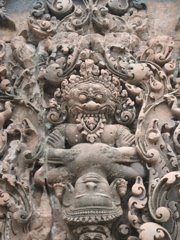
Consecrated in 967, Banteay Srei was the only major temple at Angkor not built for the king; instead it was constructed by one of king Rajendravarman's counsellors, Yajnyavahara. The temple was primarily dedicated to Shiva (the southern buildings and the central tower were devoted to him, but the northern ones to Vishnu).

Visiting this one temple costs us US$40. Well, actually it costed Tawfiq USS40 :p
But it really is a worthwhile trip. Banteay Srei has totally different architectural style compared to most of the temples I saw and most of the cravings are still visible even after over a thousand years.
Noticeably, the structures are very much smaller because the temple is built by the king's guru. Hence, it cannot be as big as the king's temples. But when I was walking through some doors, I wondered, "why not smaller doors?"
Because I'm was always in bowing position.
hmm...
Spring Cleaning
What a day!
I cleaned my room, fixed up the CD shelf I bought from IKEA before I went to Cambodia, arranged my CDs into the shelf, ironed my clothes, packed away my old clothes, and tidied my drawers.
As I was cleaning my room today, a fear strike me.
I wonder what it will like when I will live by myself eventually.
I will have laundry to do, floors to mop, toilets to clean, a kitchen, a living room to tidy...
gasp.
Because to be honest, while people have been planning the activities to do for today's public holiday, I have actually been thinking only about my messy room, my clothes waiting to be ironed and my CD shelf.
And I have been secretly hoping that no one talks about going out and was shunning partying plans.
I'm an obsessed desperate househusband.
And I do like it
I cleaned my room, fixed up the CD shelf I bought from IKEA before I went to Cambodia, arranged my CDs into the shelf, ironed my clothes, packed away my old clothes, and tidied my drawers.
As I was cleaning my room today, a fear strike me.
I wonder what it will like when I will live by myself eventually.
I will have laundry to do, floors to mop, toilets to clean, a kitchen, a living room to tidy...
gasp.
Because to be honest, while people have been planning the activities to do for today's public holiday, I have actually been thinking only about my messy room, my clothes waiting to be ironed and my CD shelf.
And I have been secretly hoping that no one talks about going out and was shunning partying plans.
I'm an obsessed desperate househusband.
And I do like it
Labels: Life
Wednesday, August 09, 2006
Forbidden City: Portrait of an Empress
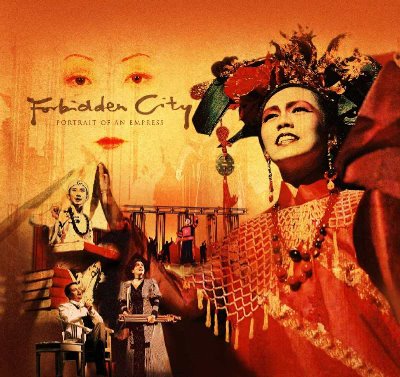
A historical retelling of the story of China's Empress Dowager, the story is seen from the eyes of an American painter, Kate Carl, who is commissioned to paint the Empress's portrait. The Empress recounts her amazing journey from a young imperial concubine to become the Empress of China and the pressures she faced. The musical explores the myths surrounding her reign, from the controversial death of her only son to her ambitious tussle for power. Having played to 60,000 people in 2003, Forbidden City is Singapore's most successful musical to date. Starring Asian sensation Kit Chan.
Front row tickets for me and Qijin.
Yeah!

Singapore Repertory Theatre
Labels: Musicals
Tuesday, August 08, 2006
Cambodia
The Kingdom of Cambodia is a country in Southeast Asia with a population of more than 13 million. Cambodia is the successor state of the once powerful Khmer Empire, which ruled most of the Indochinese Peninsula between the 11th and 14th centuries.
A citizen of Cambodia is usually identified as "Cambodian". "Khmer", which strictly only refers to ethnic Khmers, is also used. Most Cambodians are Theravada Buddhists of Khmer extraction, but the country also has a substantial number of predominantly Muslim Cham, as well as small hill tribes.
The country shares a border with Thailand to its west and north, with Laos to its northeast, and with Vietnam to its east. In the south it faces the Gulf of Thailand. The geography of Cambodia is dominated by the Mekong river (colloquial Khmer: Tonle Thom or "the great river") and the Tonle Sap ("the fresh water river"), an important source of fish.
Cambodia has a tropical climate - rainy, monsoon season from May to October and dry season from December to March. The terrain is mostly low, flat plains with mountains in the south-west and north. Natural resources include timber, gemstones, manganese, phosphates and hydropower potential.
Rate of literacy about 48 percent.
Average life expectancy 48.5 years (male 47 years, female 49.9 years) for the period 1985-90; some prevalent diseases are tuberculosis, malaria, infectious and parasitical illnesses; infant mortality 160 per thousand live births (1986); nonspecific gastro-enteritis accounts for disproportionate number of infant deaths; localized malnutrition and poor hygienic conditions exacerbate debility of population and susceptibility to illness. Total of 34 hospitals and 1,349 rural dispensaries nationwide; in countryside, network of primary care facilities being established with international help; hospitals planned or already established in provincial capitals, dispensaries at district (srok) level, first aid stations at village (khum) level; extension of health care greatly impeded by lack of trained personnel and inadequately developed infrastructure (especially clean water, and distribution or availability of medical supplies/equipment.)
Since independence, the official name of Cambodia has changed several times, following the troubled history of the country. The following names have been used in English and French since 1953.
● Kingdom of Cambodia/Royaume du Cambodge under the rule of the monarchy from 1953 through 1970;
● Khmer Republic/République Khmère (a calque of French Republic) under the Lon Nol led government from 1970 to 1975;
● Democratic Kampuchea/Kampuchea démocratique under the rule of the communist Khmer Rouge from 1975 to 1979;
● People's Republic of Kampuchea/République populaire du Kampuchea (a calque of People's Republic of China) under the rule of the Vietnamese-sponsored government from 1979 to 1989;
● State of Cambodia/État du Cambodge (a neutral name, while deciding whether to return to monarchy) under the rule of the United Nations transitional authority from 1989 to 1993;
● Kingdom of Cambodia/Royaume du Cambodge (return to the pre-1970's name) used after the restoration of the monarchy in 1993.
Despite recent progress, the Cambodian economy continues to suffer from the effects of decades of civil war, internal strife and rampant corruption. The per capita income is rapidly increasing, but is low compared with other countries in the region. Most rural households depend on agriculture and its related sub-sectors. Rice, fish, timber, garments and rubber are Cambodia's major exports, and the United States, Singapore, Japan, Thailand, Hong Kong, Indonesia and Malaysia are its major export partners.
The recovery of Cambodia's economy slowed dramatically in 1997-1998 due to the regional economic crisis, civil violence, and political infighting. Foreign investment and tourism also fell off drastically. Since then however, growth has been steady. In 1999, the first full year of peace in 30 years, progress was made on economic reforms and growth resumed at 5.0%. Despite severe flooding, GDP grew at 5.0% in 2000, 6.3% in 2001, and 5.2% in 2002. Tourism was Cambodia's fastest growing industry, with arrivals increasing from 219,000 in 1997 to 1,055,000 in 2004. During 2003 and 2004 the growth rate remained steady at 5.0%, while in 2004 inflation was at 1.7% and exports at $1.6 billion US dollars. As of 2005, GDP per Capita was $2,200 USD, which ranked it 178th (out of 233) countries.
The tourism industry is the country's second-greatest source of hard currency after the textile industry. More than 60% of visitor arrivals are to Angkor, and most of the remainder to Phnom Penh. Other tourist hotspots include Sihanoukville in the southeast which has several popular beaches, and the nearby area around Kampot including the Bokor Hill Station.

Angkor was the site of a series of capital cities of the Khmer empire for much of the period from the 9th century to the 15th century CE. Their ruins (13°24'N, 103°51'E) are located amid forests and farmland to the north of the Great Lake (Tonle Sap), near present day Siem Reap, Cambodia, and are a UNESCO World Heritage Site. The temples of the Angkor area number over one thousand, ranging in scale from nondescript piles of brick rubble scattered through rice fields to the magnificent Angkor Wat, said to be the world's largest single religious monument. Many of the temples at Angkor have been restored, and together they comprise the premier collection of examples of Khmer architecture. Visitor numbers approach one million annually.

Over a period of 300 years, between 900 and 1200 AD, the Khmer empire produced some of the world's most magnificent architectural masterpieces on the northern shore of the Tonle Sap, near the present town of Siem Reap. Most are concentrated in an area approximately 15 miles east to west and 5 miles north to south, although the Angkor Archaeological Park which administers the area includes sites as far away as Kbal Spean, about 30 miles to the north. Some 72 major temples or other buildings dot the area.
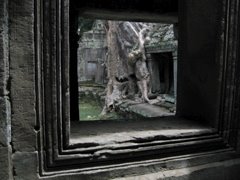
The principal temple, Angkor Wat, was built between 1112 and 1150 by Suryavarman II. With walls nearly one-half mile on each side, Angkor Wat portrays the Hindu cosmology with the central towers representing Mount Meru, home of the gods; the outer walls, the mountains enclosing the world; and the moat, the oceans beyond. The later capital of Angkor Thom, built after the Cham sack of 1177, has at its centre the Bayon. Construction of Angkor Thom coincided with a change from Hinduism to Mahayana Buddhism. Temples were altered to display images of the Buddha, and Angkor Wat briefly became a Buddhist shrine. A subsequent Hindu revival included a large-scale campaign of desecration of Buddhist images, before Theravada Buddhism became established from the 14th century.

During the 15th century, nearly all of Angkor was abandoned after Siamese attacks, except Angkor Wat, which remained a shrine for Buddhist pilgrims. The great city and temples remained largely cloaked by the forest until the late 19th century when French archaeologists began a long restoration process. From 1907 to 1970 restoration of Angkor was under the direction of the Ecole Française d'Extrême-Orient, which worked to clear away the forest, repair foundations, and install drains to protect the buildings from water damage. After the end of the civil war, work began again, and since 1993 it has been jointly co-ordinated by the French, Japanese and UNESCO through the International Co-ordinating Committee on the Safeguarding and Development of the Historic Site of Angkor (ICC), while Cambodian work is carried out by the Authority for the Protection and Management of Angkor and the Region of Siem Reap (APSARA), created in 1995. Some temples have been carefully taken apart stone by stone and reassembled on concrete foundations. Since the end of the civil war, international tourism to Angkor has increased, posing additional conservation problems but also financial assistance to the restoration projects.
Cambodia Information Center
Wikipedia: Cambodia
Country Studies: Cambodia
UNESCO World Heritage Centre
A citizen of Cambodia is usually identified as "Cambodian". "Khmer", which strictly only refers to ethnic Khmers, is also used. Most Cambodians are Theravada Buddhists of Khmer extraction, but the country also has a substantial number of predominantly Muslim Cham, as well as small hill tribes.
The country shares a border with Thailand to its west and north, with Laos to its northeast, and with Vietnam to its east. In the south it faces the Gulf of Thailand. The geography of Cambodia is dominated by the Mekong river (colloquial Khmer: Tonle Thom or "the great river") and the Tonle Sap ("the fresh water river"), an important source of fish.
Cambodia has a tropical climate - rainy, monsoon season from May to October and dry season from December to March. The terrain is mostly low, flat plains with mountains in the south-west and north. Natural resources include timber, gemstones, manganese, phosphates and hydropower potential.
Rate of literacy about 48 percent.
Average life expectancy 48.5 years (male 47 years, female 49.9 years) for the period 1985-90; some prevalent diseases are tuberculosis, malaria, infectious and parasitical illnesses; infant mortality 160 per thousand live births (1986); nonspecific gastro-enteritis accounts for disproportionate number of infant deaths; localized malnutrition and poor hygienic conditions exacerbate debility of population and susceptibility to illness. Total of 34 hospitals and 1,349 rural dispensaries nationwide; in countryside, network of primary care facilities being established with international help; hospitals planned or already established in provincial capitals, dispensaries at district (srok) level, first aid stations at village (khum) level; extension of health care greatly impeded by lack of trained personnel and inadequately developed infrastructure (especially clean water, and distribution or availability of medical supplies/equipment.)
Since independence, the official name of Cambodia has changed several times, following the troubled history of the country. The following names have been used in English and French since 1953.
● Kingdom of Cambodia/Royaume du Cambodge under the rule of the monarchy from 1953 through 1970;
● Khmer Republic/République Khmère (a calque of French Republic) under the Lon Nol led government from 1970 to 1975;
● Democratic Kampuchea/Kampuchea démocratique under the rule of the communist Khmer Rouge from 1975 to 1979;
● People's Republic of Kampuchea/République populaire du Kampuchea (a calque of People's Republic of China) under the rule of the Vietnamese-sponsored government from 1979 to 1989;
● State of Cambodia/État du Cambodge (a neutral name, while deciding whether to return to monarchy) under the rule of the United Nations transitional authority from 1989 to 1993;
● Kingdom of Cambodia/Royaume du Cambodge (return to the pre-1970's name) used after the restoration of the monarchy in 1993.
Despite recent progress, the Cambodian economy continues to suffer from the effects of decades of civil war, internal strife and rampant corruption. The per capita income is rapidly increasing, but is low compared with other countries in the region. Most rural households depend on agriculture and its related sub-sectors. Rice, fish, timber, garments and rubber are Cambodia's major exports, and the United States, Singapore, Japan, Thailand, Hong Kong, Indonesia and Malaysia are its major export partners.
The recovery of Cambodia's economy slowed dramatically in 1997-1998 due to the regional economic crisis, civil violence, and political infighting. Foreign investment and tourism also fell off drastically. Since then however, growth has been steady. In 1999, the first full year of peace in 30 years, progress was made on economic reforms and growth resumed at 5.0%. Despite severe flooding, GDP grew at 5.0% in 2000, 6.3% in 2001, and 5.2% in 2002. Tourism was Cambodia's fastest growing industry, with arrivals increasing from 219,000 in 1997 to 1,055,000 in 2004. During 2003 and 2004 the growth rate remained steady at 5.0%, while in 2004 inflation was at 1.7% and exports at $1.6 billion US dollars. As of 2005, GDP per Capita was $2,200 USD, which ranked it 178th (out of 233) countries.
The tourism industry is the country's second-greatest source of hard currency after the textile industry. More than 60% of visitor arrivals are to Angkor, and most of the remainder to Phnom Penh. Other tourist hotspots include Sihanoukville in the southeast which has several popular beaches, and the nearby area around Kampot including the Bokor Hill Station.

Angkor was the site of a series of capital cities of the Khmer empire for much of the period from the 9th century to the 15th century CE. Their ruins (13°24'N, 103°51'E) are located amid forests and farmland to the north of the Great Lake (Tonle Sap), near present day Siem Reap, Cambodia, and are a UNESCO World Heritage Site. The temples of the Angkor area number over one thousand, ranging in scale from nondescript piles of brick rubble scattered through rice fields to the magnificent Angkor Wat, said to be the world's largest single religious monument. Many of the temples at Angkor have been restored, and together they comprise the premier collection of examples of Khmer architecture. Visitor numbers approach one million annually.

Over a period of 300 years, between 900 and 1200 AD, the Khmer empire produced some of the world's most magnificent architectural masterpieces on the northern shore of the Tonle Sap, near the present town of Siem Reap. Most are concentrated in an area approximately 15 miles east to west and 5 miles north to south, although the Angkor Archaeological Park which administers the area includes sites as far away as Kbal Spean, about 30 miles to the north. Some 72 major temples or other buildings dot the area.

The principal temple, Angkor Wat, was built between 1112 and 1150 by Suryavarman II. With walls nearly one-half mile on each side, Angkor Wat portrays the Hindu cosmology with the central towers representing Mount Meru, home of the gods; the outer walls, the mountains enclosing the world; and the moat, the oceans beyond. The later capital of Angkor Thom, built after the Cham sack of 1177, has at its centre the Bayon. Construction of Angkor Thom coincided with a change from Hinduism to Mahayana Buddhism. Temples were altered to display images of the Buddha, and Angkor Wat briefly became a Buddhist shrine. A subsequent Hindu revival included a large-scale campaign of desecration of Buddhist images, before Theravada Buddhism became established from the 14th century.

During the 15th century, nearly all of Angkor was abandoned after Siamese attacks, except Angkor Wat, which remained a shrine for Buddhist pilgrims. The great city and temples remained largely cloaked by the forest until the late 19th century when French archaeologists began a long restoration process. From 1907 to 1970 restoration of Angkor was under the direction of the Ecole Française d'Extrême-Orient, which worked to clear away the forest, repair foundations, and install drains to protect the buildings from water damage. After the end of the civil war, work began again, and since 1993 it has been jointly co-ordinated by the French, Japanese and UNESCO through the International Co-ordinating Committee on the Safeguarding and Development of the Historic Site of Angkor (ICC), while Cambodian work is carried out by the Authority for the Protection and Management of Angkor and the Region of Siem Reap (APSARA), created in 1995. Some temples have been carefully taken apart stone by stone and reassembled on concrete foundations. Since the end of the civil war, international tourism to Angkor has increased, posing additional conservation problems but also financial assistance to the restoration projects.
Cambodia Information Center
Wikipedia: Cambodia
Country Studies: Cambodia
UNESCO World Heritage Centre
Labels: Holidays
Monday, August 07, 2006
Stealing an hour from Time
When the plane landed on Thailand grounds, I was an hour behind Singapore time.
I had did many things in the past 10 days but I had an hour more to spare if I was in Singapore.
Not until 6th August 2006, 1745hr.
All good things have to come to an end.
I had to return the hour back to time.
I'm Home!!
keke
I had did many things in the past 10 days but I had an hour more to spare if I was in Singapore.
Not until 6th August 2006, 1745hr.
All good things have to come to an end.
I had to return the hour back to time.
I'm Home!!
keke
Labels: Holidays

